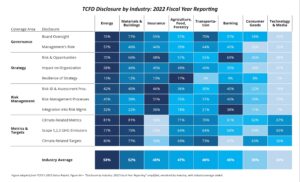The Task Force on Climate-Related Financial Disclosures (TCFD) has long been the cornerstone of global reporting on climate governance, strategy, risk management, and metrics and targets, the four categories enveloping its suite of eleven recommended disclosures. In October, TCFD’s secretariat published its sixth and final Status Report before handing the reporting reigns to the International Sustainability Standards Board.
The TCFD has garnered widespread recognition, with more than 4,850 supporters since its inception in 2015. Established by the Financial Stability Board (FSB), TCFD aims to guide companies in disclosing standardized information that can support the appropriate evaluation and pricing of climate risks by lenders, investors, and underwriters.
One of the hallmarks of the TCFD is the need to disclose “decision-useful information.” The October report indicates concern that too few companies disclose along these lines, speaking to the need to thoughtfully assess and report on crucial metrics, rather than simply follow a checklist. Much attention has mounted in recent years over the need for public companies to disclose to shareholders, but private companies alike should pay attention: as the reporting needs of active owners and sponsors grow, this will inevitably put pressure back on private firms to provide material information.
TCFD’s Status Report highlights the results of an industry survey, which scoured financial filings, annual and sustainability reports, and other documents from more than 1,350 public companies over a three-year period using web scraping AI technology. The TCFD also analyzed public reports and conducted a survey of the 50 top asset managers and asset owners (based on assets under management). Below are our key takeaways:
- Companies have determined it is relevant to disclose information on climate risks (and opportunities) en masse. As of Fiscal Year 2022, 58% of companies surveyed provided information in company reports along at least five of the 11 recommended disclosures. Nearly 70% of the top 50 asset managers and 36% of the top 50 asset owners disclosed along at least five. When so many firms provide this information as a norm, the question switches from why disclose to why not disclose, putting the onus on non-disclosers. Owners, investors, and sponsors become accustomed to seeing this data and are able to act on it, since standardization becomes possible.
- Alignment with recommended disclosures varies greatly by industry. We reviewed data from the Status Report and adapted the figure below, showing average disclosure by industry. In the TCFD report, Energy, Materials and Buildings, and Insurance companies disclosed across categories of information most on average. These three industries are particularly exposed to climate risk pressure – with energy and buildings a focus of the transition to renewable energy and insurance centered around accurate risk evaluation. Surveyed energy companies disclosing topped out above 80% in some categories. Consumer goods, technology, and media companies saw the lowest average disclosure, particularly in the risk management categories, supporting the impression that some industries see climate-related risks as less material to their business models, at least at this time.
- Despite the relative ubiquity of reporting, asset owners and managers in the survey rated their top challenge to climate reporting to be insufficient information provided from investees. Investees and portfolio company management teams should take note.
- ESG assessment and scoring has embraced the practice of web scraping to gather an extensive array of publicly accessible data from online sources. This encompasses data related to your company's environmental, social, and governance initiatives, as well as mentions in news articles, social media, and government reports. The utilization of web scraping in the context of TCFD underlines the significance of this meticulous data collection approach. We strongly recommend our clients consider a disclosure and reporting process that delivers useful information to the markets and the investment community.

Conclusions:
Financials are conducting robust reporting, which trickles down to their financed investments and directly managed portfolio companies. “Financed emissions” are receiving more focus than ever before, with pressure for financials to disclose on their pecuniary activity. Governance seems to have a particular focus for top asset managers, which disclosed on board oversight and management’s role both 64% of the time. Risk management took a large slice, as well, with more than half of asset managers disclosing in each of the areas of risk identification, risk management process, and risk management integration.
As companies across the corporate landscape endeavor to elevate their ESG disclosure rates, a notable challenge becomes apparent, as exemplified in the TCFD report survey. The data reveals that while there is a notable surge in ESG disclosure, only a minuscule fraction of companies adhere to the comprehensive disclosure recommendations laid out by the TCFD. In fact, a mere 4% of companies actually implemented all 11 of the TCFD's recommended practices, highlighting the gap between aspiration and execution in the realm of ESG reporting.
The growing appetite for ESG-related information among investors further accentuates this challenge. Investors are increasingly seeking in-depth and decision-useful ESG data to inform their investment choices. As the demand for high-quality ESG disclosure outpaces the supply, companies face an opportunity to distinguish themselves by providing robust ESG, and more specifically, climate disclosures. This challenge, while significant, also represents an avenue for companies to stand out in the crowded landscape of ESG reporting, reinforcing their commitment to transparency and their ability to meet the growing expectations of investors and stakeholders.
Mallory Rutigliano, FSI Contributing Writer
